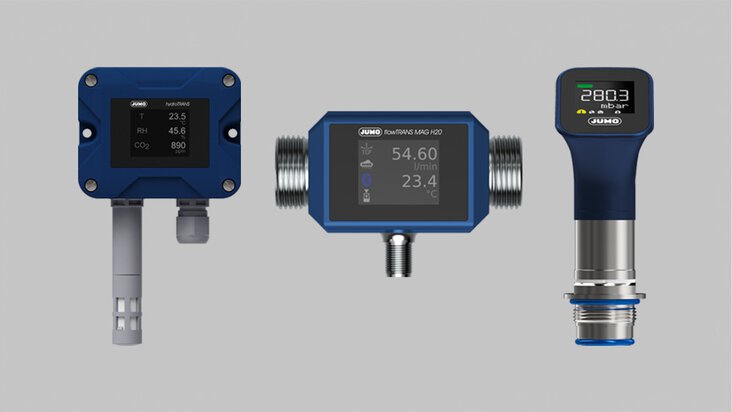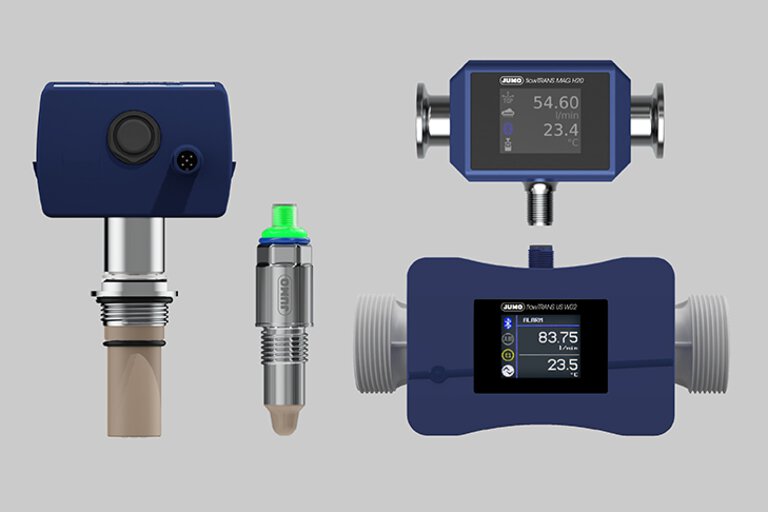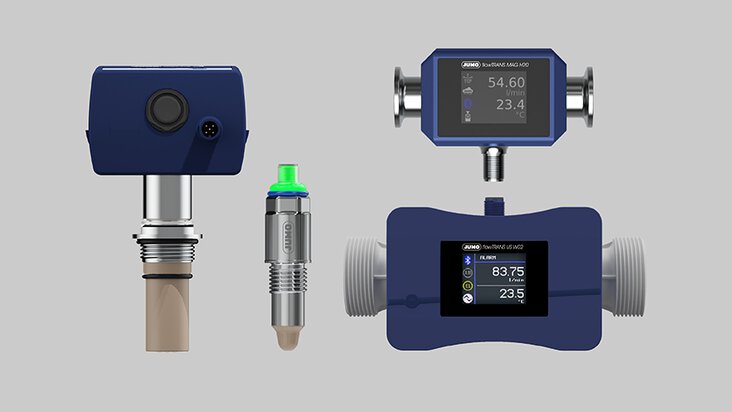
IoT Sensors at a Glance
The Internet of Things (IoT/IIoT) is revolutionizing industries by making machines, devices, and plants more intelligent as well as simplifying the interaction with them. In this context, IoT sensors play a crucial role. After all, they continuously collect information and measured values that enable informed decisions to be made about process control and optimization in industrial environments. Find out more in the FAQ section below!
Table of contents
What is the difference between IoT and IIoT?
The Internet of Things (IoT) and the Industrial Internet of Things (IIoT) are related concepts, but they differ somewhat in their application areas, requirements, and impact. While the IoT aims to improve everyday life and comfort, the IIoT focuses on increasing operational efficiency and minimizing downtime. Therefore, IoT refers to a wide range of applications in the private sector, whereas IIoT focuses specifically on industrial applications such as manufacturing automation, predictive maintenance, or supply chain optimization.
What are IoT sensors?
Industrial IoT sensors, also known as Industry 4.0 sensors, were developed specifically for M2M communication and the requirements of the Industrial Internet of Things (IIoT) in contrast to conventional sensor technology. As digital sensors, they not only acquire physical measurements, but also transmit them in real time to higher-level automation and process control systems for further processing. They are suitable for a wide range of industries and applications.
How do IoT sensors work?
IoT sensors work through the interaction of data acquisition and sensor communication. After measuring, the physical data is converted into a signal that can be read by machines and sent in real time to other parts of an industrial network, such as automation, cloud, or SCADA systems. Depending on the specific industrial application, communication can take place via Ethernet/Single Pair Ethernet (SPE), IO-Link, or wireless technologies such as Wi-Fi, LoRaWAN, Mioty, or 5G.
Why are IoT sensors so important?
IoT sensors enable real-time monitoring and control of devices and systems, which is particularly important for industries and applications where fast, data-driven decisions are essential. They also facilitate the automation of routine tasks, increase process efficiency, and support applications that are impossible or difficult to implement with conventional sensor technology. Proactive maintenance can prevent breakdowns and extend the operating life of equipment.
What types of sensors are available and which industries benefit most from them?
IoT sensors are available for different applications and a wide range of measurands. In the industrial sector, temperature sensors, humidity sensors, pressure sensors, flow sensors, liquid sensors. level sensors and gas sensors are mainly used. Among other application areas, IoT sensors are implemented in the production and process industries to automate processes, in agriculture to monitor greenhouses, and in aquaculture to ensure water quality.
How do IoT sensors influence energy efficiency?
Their ability to deliver accurate data in real time enables IoT sensors to continuously monitor the energy consumption of machines and plants. Energy consumption patterns are recognized and inefficient devices or processes are identified. Appropriate countermeasures can reduce energy consumption in the long term.

Browser-based energy management via JUMO smartWARE SCADA
How do IoT sensors affect sustainability?
In addition to energy balance, resource management also benefits from modern IoT sensor technology. These innovative sensors enable precise irrigation and fertilization in agriculture, thereby preventing water waste and overfertilization. The same applies to defects in the manufacturing industry, which can be minimized through more precise monitoring of production lines. In addition, downtime is avoided through effective inventory management of storage tanks for liquids and industrial gases, which enables cost-optimized route planning.
What role do IoT sensors play in process reliability?
IoT sensors can help improve safety in industrial environments. After all, continuous monitoring of machines and plants facilitates the early detection of potential safety risks. Various types of sensors can be used for such purposes as to acquire temperature or pressure deviations which indicate an impending failure or a dangerous situation. This enables proactive measures to be taken to prevent accidents as well as to ensure the safety of employees and plants.
What is the significance of Single Pair Ethernet (SPE) for IoT sensors?
SPE offers several important advantages for IoT sensors. These methods include:
Simplicity and cost savings
Unlike traditional 4 or 8 wires, SPE uses only 1 pair of copper wires for data transmission. This reduction simplifies cabling and installation, which leads to lower material and labor costs.
Space and weight reduction
The reduced cabling makes SPE sensors lighter and more compact than conventional sensors. They are therefore ideal for use in densely packed industrial environments.
Energy efficiency
SPE supports Power over Data Line (PoDL) and transmits current as well as data via the same cable. This simplifies the design of IoT sensor applications by eliminating the need for separate power supply lines.
Increased range
SPE can transfer data over longer distances than conventional Ethernet solutions. It offers a range of up to 1000 meters, which is a significant improvement on the 100 meters that was standard in the past. This is particularly useful for large industrial plants or distributed systems.
High data transmission rates
Single Pair Ethernet supports high data transmission rates of up to 10 Gbit/s. This allows applications with high bandwidths to be covered. An example here is the precise control and monitoring of complex control loops in process automation.
Cloud connection
SPE enables direct sensor connection to cloud systems; additional edge gateways are not required.
Robustness and reliability
SPE is resistant to malfunctions as well as environmental influences and is designed for use in harsh environments. This robustness makes the technology ideal for applications that are exposed to harsh environmental influences.
Interoperability and standardization
The growing acceptance of SPE as the standard for industrial communication promotes interoperability between different devices and systems. This simplifies the integration of IoT sensors into existing networks and systems.
What is the significance of intelligent sensors with IO-Link?
As an intelligent communication protocol, IO-Link enables seamless connection to industrial networks and IIoT environments. The most important advantages include:
Bidirectional/digital communication
IO-Link enables bidirectional communication between sensors/actuators and control systems. This means that not only is data sent from the devices to the control system, but control commands and configuration data can also be sent back to the devices. The digital communication improves the flexibility and adaptability of automation systems, as devices can be quickly and easily reconfigured to meet changing requirements.
Predictive maintenance
IO-Link communication transfers diagnostic and other metadata (manufacturer information, software version, etc.) that is crucial for predictive maintenance. By continuously monitoring device status and analyzing diagnostic data, potential problems can be identified and resolved early on before they lead to failures. This increases plant availability and reduces maintenance costs, as maintenance measures can be carried out in a targeted and needs-based manner.
Cloud connection
IO-Link devices can be connected directly to cloud platforms via IO-Link master with a cloud interface or corresponding gateways. This allows sensor data to be collected, analyzed, and visualized centrally – a crucial component for IIoT applications. Companies benefit from greater transparency, more efficient processes, data-driven decisions, as well as expanded remote monitoring and control options.
Manufacturer-independent configuration interface
IO-Link is an international standard according to IEC 61131-9. This means that users can easily configure and operate devices from a wide range of manufacturers via a uniform infrastructure. This optimizes training, startup, and operating times compared to proprietary solutions.
How are AI labeling and IoT sensor technology related?
Artificial intelligence plays a crucial role in the effective use of Industry 4.0 sensors. After all, the collected sensor data is annotated by AI with informative labels that describe specific features or conditions within the data. This enables AI systems to learn from the data and recognize patterns.
In addition, accurate AI labeling can identify and correct errors, inconsistencies, and ambiguities in the data, which leads to more precise and reliable measured values.
How does one find the right sensors for IIoT applications?
The use of sensors depends on the requirements or the various features in applications. SPE sensors with Power over Data Line (PoDL) are ideal for implementing Ethernet connections over distances of up to 1000 meters. This feature is necessary for such uses as climate monitoring of large warehouses or greenhouses.
IO-Link, on the other hand, facilitates adaptation to changing production requirements and increases the efficiency of production lines due to the flexible integration and quick configuration of sensors and actuators. In the chemical and pharmaceutical industries, IO-Link supports precise process monitoring and control by providing detailed diagnostic data, which simplifies maintenance and improves process reliability.
If necessary, a specialist in sensor technology should be consulted when selecting the appropriate sensor technology. This is especially true for complex requirements that cannot be adequately met by standard Industry 4.0 sensors.
- ${title}${badge}




